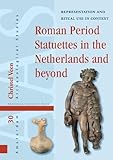Roman Period Statuettes in the Netherlands and beyond : Representation and Ritual Use in Context / Christel Veen.
Material type: TextSeries: Amsterdam Archaeological Studies ; 30Publisher: Amsterdam : Amsterdam University Press, [2023]Copyright date: ©2023Description: 1 online resource (332 p.)Content type:
TextSeries: Amsterdam Archaeological Studies ; 30Publisher: Amsterdam : Amsterdam University Press, [2023]Copyright date: ©2023Description: 1 online resource (332 p.)Content type: - 9789048557004
- Bronze figurines, Roman -- History -- To 1500 -- Netherlands
- Bronze figurines, Roman -- Netherlands -- History -- To 1500
- Terra-cotta figurines, Roman -- History -- To 1500 -- Netherlands
- Terra-cotta figurines, Roman -- Netherlands -- History -- To 1500
- Antiquity
- Archaeology
- History, Art History, and Archaeology
- Religion and Theology
- Sociology and Social History
- HISTORY / Ancient / Rome
- Roman period statuettes, distribution patterns, iconography
- 733/.509369 23/eng/20230426
- NB158.9 .V44 2023
- online - DeGruyter
| Item type | Current library | Call number | URL | Status | Notes | Barcode | |
|---|---|---|---|---|---|---|---|
 eBook
eBook
|
Biblioteca "Angelicum" Pont. Univ. S.Tommaso d'Aquino Nuvola online | online - DeGruyter (Browse shelf(Opens below)) | Online access | Not for loan (Accesso limitato) | Accesso per gli utenti autorizzati / Access for authorized users | (dgr)9789048557004 |
Frontmatter -- CONTENTS -- ACKNOWLEDGEMENTS -- 1 A rare category of artefacts -- 2 Catalogue and description of find-spots -- 3 Spatial and iconographic analysis -- 4 Rituals with statuettes -- 5 Summary and conclusions -- Abbreviations -- Bibliography -- List of maps, figures and drawings -- Figures -- Tables
restricted access online access with authorization star
http://purl.org/coar/access_right/c_16ec
The subject of this study is a relatively rare category of artefacts, bronze and terracotta statuettes that represent deities, human figures and animals. They were introduced in the northwestern provinces by Roman troops from the end of the 1st century BCE onwards. The statuettes have been recovered from military and non-military settlements, the surrounding landscape and, to a far lesser extent, from sanctuaries and graves. Until now, their meaning and function have seldom been analysed in relation to their find-spots. Contrary to traditional studies, they have been examined as one separate category of artefacts, which offers new insights into the distribution pattern and iconographic representation of deities. When studying a group of artefacts, a large research area or a large dataset is required, as well as dateable artefacts and find-contexts. These conditions do not apply to the Netherlands and to the majority of statuettes that are central to this study. Moreover, although the changing appearance of statuettes suggest a transformation of cults, the identities of the owners of these statuettes remain invisible to us. Therefore, the issue of Romanization is not put central here. Instead, the focus is on a specific aspect of religion, known as lived religion, within the wider subject of its transformation in the Roman period: how people used statuettes in everyday life, in the context of their houses and settlements.
Mode of access: Internet via World Wide Web.
In English.
Description based on online resource; title from PDF title page (publisher's Web site, viewed 06. Mrz 2024)


